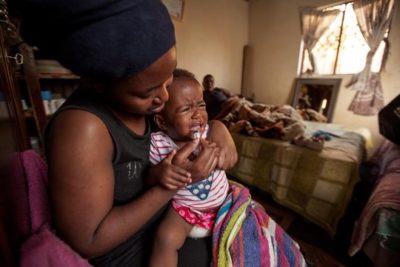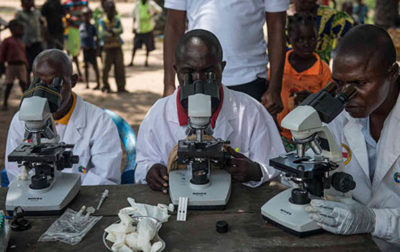Rachel Cohen is the regional executive director of the Drugs for Neglected Diseases initiative (DNDi), a nonprofit drug research and development organization focused on diseases such as leishmaniasis and sleeping sickness. Previously, she worked with Doctors Without Borders, leading programs for treating HIV/AIDS and tuberculosis in rural settings.
Q: When developing treatments for neglected disease, how do you prioritize the diseases you would like to address?
A: DNDi originated as a response to frustrated Doctors Without Borders/Médecins Sans Frontières (MSF) medical teams whose tools occasionally were terribly inadequate. The drugs for treating some diseases were too expensive, had become ineffective because of resistance, or affected people in a market that held no interest for the pharmaceutical industry. So we initially focused on what we called the "most neglected diseases": sleeping sickness, leishmaniasis, and Chagas disease.

A mother struggles to give her child horrible-tasting HIV medicines in a township in Durban, South Africa. DNDi is developing a child-friendly formulation of this important medication.
Over the years, different groups have approached us to see if we could apply our experience in developing drugs to other challenges. For example, MSF and Unitaid asked us to develop pediatric formulations of antiviral therapies. The research pipeline for human immunodeficiency virus (HIV) is extremely rich, but because so few children are born with HIV in wealthy countries, few companies had explored adapting the drugs for infants and young children, who are at a higher risk of dying from HIV. Likewise, it's a golden age for hepatitis C research, but the antiviral drugs to treat it are too expensive for the overwhelming majority of people in the world.
How we set our priorities is a subjective process. We look at the global disease burden and mortality rates and listen very carefully to our partners and our stakeholders, especially those on the front lines of treating diseases in low- and middle-income countries. We are not a government agency, so we are not bound by any national or economic interests, which allows us a lot of flexibility to develop priorities based on needs alone. We are interested in whether the patients are experiencing some level of neglect, if there is something that can be done about it scientifically, and if there are potential partners that could come together to deliver an affordable therapeutic intervention.
Q: What do you find makes a successful collaboration with a pharmaceutical partner?
A: We try to ensure that there is a shared vision in a given project. That includes organizing everything from intellectual property management to licensing terms to treatment affordability. For example, the first treatment DNDi delivered back in 2007 was an antimalarial combination we developed with Sanofi, one of our strongest industrial partners. We agreed at the beginning that a full course of treatment for an adult would cost no more than $1, and for children, no more than $0.50. To date, we have distributed more than 500 million treatments, and Sanofi has honored that price agreement. We are now transferring the technology from Sanofi to a Tanzanian company that will supply the drug for the African market going forward.
Q: What motivates the pharmaceutical companies to join these arrangements?
A: We often hear from our scientist collaborators that these projects are hugely rewarding. Their efforts go to the public good. Some companies are motivated by positive visibility and corporate responsibility. Some may even have a commercial interest in early access to emerging markets. I can't speculate on the balance of those particular motivators, but my hope is that the collaboration is particularly rewarding for the scientists and a win-win for the company.

DNDi-supported mobile teams testing for sleeping sickness in the Bandundu province of the Democratic Republic of Congo.
Q: Do you also collaborate with governments?
A: We bring together local clinicians in the affected countries, disease regulators, and researchers to establish a target product profile, which includes goals such as a price ceiling, oral administration, heat stability, and standards for efficacy and safety. We also work closely with ministries of health in countries where we conduct phase II and III clinical studies. We do a lot of training and system strengthening so that trials can be performed according to international ethical standards. We cannot possibly conduct our trials or introduce and implement the treatments without working hand in hand with ministries of health in the affected countries. In addition, approximately 50% of our funding comes from governments, with the other 50% coming from private philanthropies.
Q: What changed over the last two decades to facilitate these large-scale global health partnerships?
A: For me, there's no doubt that the interest in global public health we have today arose because of AIDS activism in the '80s and '90s. Antiretroviral therapy in the United States highlighted the gross inequity of a $10,000-$15,000 treatment that prolonged the lives of people with HIV in rich countries, but was totally unavailable to the overwhelming majority of people living with HIV. This forced policy makers, researchers, and people at the US Food and Drug Administration and other regulatory agencies to view AIDS as a political crisis. That's what gave birth to funds and initiatives to fight disease in the developing world and what helped boost the US National Institutes of Health budget over the years. AIDS activists who fought for equitable access to treatment fueled the entire global health enterprise.
More recently, people became concerned about the globalization of intellectual property rules and the high prices of medicines, bringing trade discussions into health and vice versa. Additionally, the Ebola virus epidemic in West Africa made it glaringly clear that we didn't have the tools that we needed. We were caught completely off guard. National security concerns, global health security, and the notion that a disease could get on a plane and come here drew a lot of attention, bringing a resurgence in pandemic preparedness interest over the last 4-5 years.
Antimicrobial resistance is a slower-burning crisis looming on the horizon, and my personal view is that the effects of climate change on health will be another challenge. These problems have already captured some political attention. The question is if we can sustain the necessary level of engagement from policy makers and society to bring about the investment and commitment to really solve the problem.
